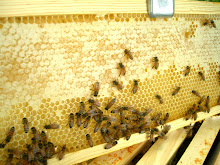For a moment, I panicked. I'm a novice beekeeper with only one hive, for pete's sake. I knew what a swarm was, but had no idea how to go about collecting one. There wasn't much time until the swarm would decide to move on, so I pulled myself together and thought about who to call. I remembered that my friend Cookie and I had discussed bees a few months ago and she mentioned that she knew beekeeping guru Cindy Bee. (Yes, that is actually her name and it is certainly appropriate!) Cookie had emailed Cindy Bee's contact information to me. I found the email and quickly dialed Cindy, who took time out of her busy schedule to give me some quick pointers over the phone.
Since I don't have a second hive box yet, I would have to assemble a makeshift hive from whatever we had on hand in the garage. First, Cindy advised me to use plywood and 2x4's to make a bottom board. I had sheets of plywood, but not 2x4s, so I used bricks. Next, I was to take a cardboard box and cut a small horseshoe-shaped hole in the bottom to make a flap that would open for the bees to enter and exit. Then Cindy said I should spray a small amount of lemon-scented Pledge or lemon juice around the opening, which would help attract the bees. I had two extra supers on hand, so I removed some of the frames from one super and put them in the cardboard box, as instructed.
It was time to suit up and head over to Oscar's yard to collect the swarm. Using my bee brush, I brushed the bees (thousands of them) downward from the umbrella into the box. They seemed happy to land in the lemon-scented box and quickly crawled onto the frames. I set the open box on the patio table for a while and the remaining bees that were flying around eventually headed into the box. I'd say I collected about 99% of the swarm before I put a lid on the box and took the bees back to my yard.
Then came the hard part. I set the box on the makeshift landing board and pulled the flap open from underneath to give the bees an entrance and exit. Next, I put a super with frames on top of the cardboard box. Per Cindy's instructions, the bees needed to be fed with the 1:1 sugar/water solution, so that required some ingenuity on my part. I had a mason jar on hand, but no ice pick with which to poke small holes in the top — I ended up using a seam-ripper from my sewing kit to make the perfect little bee-sized drinking holes in the top of the jar. I took the jar, filled with sugar-water, and my last unused super (empty, no frames) out to the makeshift hive. This top super would protect the feeding jar, which I turned upside down on top of the frames in the super below. I covered the whole thing with another piece of plywood.
To sum up the configuration from the bottom up: plywood bottom board, bricks, cardboard box with bees, super with frames, feeder jar inside empty super, plywood cover. It's a little sad-looking, but I hope it will do the job temporarily.

A quick peek under the plywood cover showed that the swarm bees had already found the sugar-water. Cindy warned that my original hive would be very interested in this new, weaker hive and its sugar-water supply and might try to "rob" it. She cautioned me to find and seal all of the openings, leaving only one space of about an inch or so for the swarm bees to enter and exit their hive. This would give them a better chance of protecting their hive and sugar-water supply from intruders. Since the cardboard box was sagging in places and there were odd-shaped openings all around, I decided to use newspaper to stuff the holes. It remains to be seen if this method is successful — every time I checked the hive this afternoon I saw the crafty little winged creatures entering and exiting new places, so I had to plug those with paper. May have to pull out the duct tape soon.
I also needed to check the original hive and see what was going on, Cindy advised. I took off the cover and saw that the boxes were full of bees. No beetles in sight. That's a good sign, she said. I hope this means that the bees swarmed because the original hive was too congested — they split to form a new colony.
I called Brushy Mountain Bee Company and ordered a hive right away. The cost to ship it to me overnight was prohibitive. Wendy reassured me they would ship my order out today, so I opted for regular shipping. I'll probably get my order on Monday, but if I'm lucky, it could come sooner. Then I'll set up the new hive in a permanent location and move the swarm bees from their makeshift home. That's assuming they survive the weekend, the other hive doesn't decide to "rob" them, and they don't decide to swarm again and go somewhere else.
I'm grateful for the generosity of neighbors, friends and an expert who doesn't know me from Adam's house cat. What an exciting and rewarding experience.

Great story! You should write a bee book - it's such a neat hobby.
ReplyDeleteWhat a fascinating story!! I was riveted with all drama and knew how I would have panicked if anything like that happened to me. I can't wait for the next installment to see if the new hive arrives in time and what the bees do then.
ReplyDeleteI see a book in the future about all this.